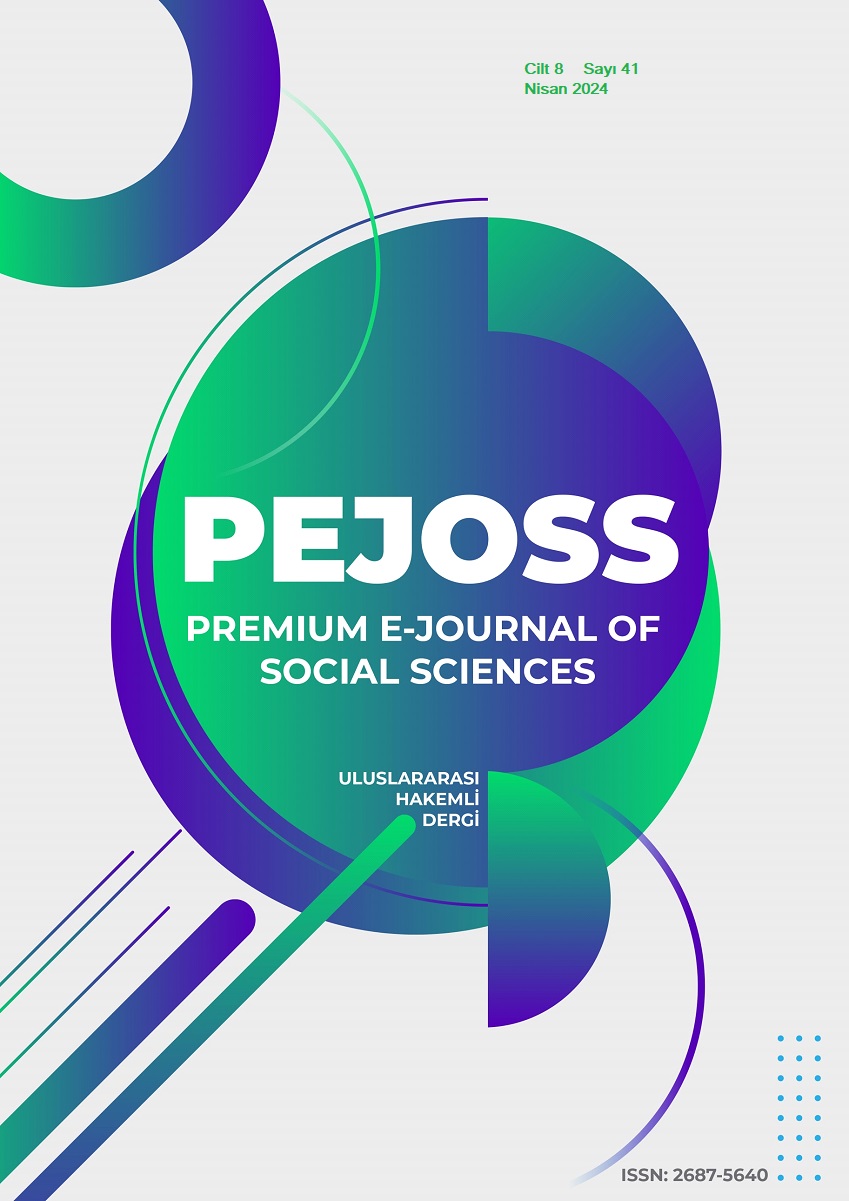Investigation of Foreign Language Pronunciation Anxiety of University Students
DOI:
https://doi.org/10.5281/zenodo.11117262Keywords:
Foreign Language Pronunciation Anxiety, English Language Teaching, Speaking AnxietyAbstract
In this study, university students' foreign language pronunciation concerns were investigated. In the research conducted according to the survey model, the level of foreign language pronunciation anxiety of university students receiving preparatory education at Inonu University and whether these pronunciation concerns differ significantly in terms of some independent variables were investigated. No sampling was done within the scope of the research, and an attempt was made to reach the entire population(universe), but students who were absent during the period when the data collection tool was applied and did not want to participate in the research were not included in the scope of the research. In this context, 231 university students constituted the participants of the research. As a result of the research, it was concluded that the pronunciation anxiety of the research participants was low, pronunciation anxiety did not differ significantly according to the status of taking a course in a foreign language, perception of competence and the department studied, whereas perception of success significantly differentiated pronunciation anxiety. It was determined that the gender variable caused a significant difference only in the verbal performance dimension. When the research findings are compared with the opinions and findings in the literature, it can be said that foreign language speaking anxiety can be overcome with practice, and teachers' choices and approaches in the learning-teaching process are effective in reducing this level of anxiety. It is recommended that teachers include applications in alignment with language skills in foreign language classes.
Downloads
References
Baran-Łucarz, M. (2014). The link between pronunciation anxiety and willingness to communicate in the foreign-language classroom: The polish EFL context. Canadian Modern Language Review, 70(4), 445–473. https://doi.org/10.3138/cmlr.2666 (Accessed : 06.12.2023).
Baran-Lucarz, M. (2016). Conceptualizing and measuring the construct of pronunciation anxiety: Results of a pilot study. In M. Pavlak (Edt.), Classroom-oriented research: Reconciling theory and practice (pp. 39-56). Springer International Publishing Switzerland. doi:10.1007/978-3-319-30373-4_3
Cao, Y. (2013). Exploring dynamism in willingness to communicate: A longitudinal case study. Australian Review of Applied Linguistics, 36, 160–176.
Celce-Murcia, M., Brinton, D.M., & Goodwin, J.M. (1996). Teaching pronunciation: A reference for teachers of English to speakers of other languages. Cambridge, UK: Cambridge University Press.
Cle´ment, R., Baker, S.C., & MacIntyre, P.D. (2003). Willingness to communicate in a second language: The effects of context, norms, and vitality. Journal of Language and Social Psychology, 22(2), 190–209. http://dx.doi.org/10.1177/ 0261927X03022002003
Dewaele, J-M., Petrides, K. V., & Furnham, A. (2008). Effects of trait emotional intelligence and sociobiographical variables on communicative anxiety and foreign language anxiety among adult multilinguals: A review and empirical investigation. Language Learning, 58(4), 911–960. Retrieved from http://dx.doi.org/10.1111/j.1467-9922.2008.00482.x Accessed:
Erdel, D. (2023). Exploring English major students’ pronunciation anxiety. International Journal of Turkish Educational Sciences, 11(21), 522-548.
Gregersen, T., & Horwitz, E. K. (2002). Language learning and perfectionism: Anxious and non-anxious language learners’ reactions to their own oral performance. Modern Language Journal, 86, 562–570.
Guiora, A., Beit-Hallahmi, B., Brannon, R., Dull, C.Y., & Scovel, T. (1972). The effects of experimentally induced changes in ego status on pronunciation ability in a second language: An exploratory study. Comprehensive Psychiatry, 13(5), 421–428. http://dx.doi.org/10.1016/0010-440X(72)90083-1.
Kafes, H. (2018). A Study on pronunciation anxiety of pre-service elt teachers; Atatürk Üniversitesi Sosyal Bilimler Enstitüsü Dergisi, 22, 1813-1827.
Kennerly, H. (1990). Managing anxiety: A training manual. Cary, NC: Oxford University Press.
Kındığılı, A.L. (2022). Ortaöğretim öğrencilerinde yabancı dilde konuşma kaygısı ile cinsiyet, okul türü ve yabancı dil eğitim geçmişi ilişkisinin incelenmesi. Spor, Eğitim ve Çocuk, 2(2), 24-35.
Levis, J. M. (2005). Changing contexts and shifting paradigms in pronunciation teaching. TESOL Quarterly, 39, 369-377.
MacIntyre, P. D., & Gardner, R. C. (1991). Investigating language class anxiety using the focused essay technique. Modern Language Journal, 75, 296–304.
MacIntyre, P. D., & Gardner, R. C. (1994). The subtle effects of language anxiety on cognitive processing in the second language. Language Learning, 44, 283–305.
MacIntyre, P. D., & Gardner, R. C. (1989). Anxiety and second language learning: Towards a theoretical clarification. Language Learning, 39, 251–275.
Özkurt, C. ve Aslan, S. (2015). Why we cannot teach a foreign language? The cognitive learning aprroach on language acquisition according to the views of language teachers. Eurasian Academy Of Sciences Social Sciences Journal, Eurasian Academy Of Sciences, 6(6), 28-35.
Price, M.L. (1991). The subjective experience of foreign language anxiety: Interviews with highly anxious students. In E.K. Horwitz & D.J. Young (Eds.), Language anxiety: From theory and research to classroom implications (pp. 101–108). Upper Saddle River, NJ: Prentice Hall.
Piechurska-Kuciel, E. (2008). Language anxiety in secondary grammar school students. Opole, Poland: Wydawnictwo Uniwersytetu Opolskiego.
Rafieyan, V. (2016). Discovering factors of foreign language speaking anxiety and coping strategies, Journal for the Study of English Linguistics,4(1), 111-125.
Savignon, S.J. (2005). Communicative language teaching: Strategies and goals. In E. Hinkel (Ed.), Handbook of research in second language teaching and learning (pp. 635–651). Mahwah, NJ: Lawrence Erlbaum.
Skehan, P. (1989). Individual differences in second language learning. London: Edward Arnold.
Sutarsyah, C. (2017). An analysis of student’s speaking anxiety and its effect on speaking performance. IJELTAL (Indonesian Journal of English Language Teaching and Applied Linguistics), 1(2), 143-152.
Tüm, D.Ö. ve Kunt, N. (2013). İngilizce öğretmen adaylarının konuşma kaygısı. Hacettepe Üniversitesi Eğitim Fakültesi Dergisi, 28(3), 385-399.
Uzan, G. (2018). Yabancı dil konuşma kaygısı/korkusunun altında yatan sebepler, anonimleşmenin ve kimlik belirsizliğinin kaygıyı azaltıcı etkileri. Yayımlanmamış Yüksek Lisans Projesi. Sakarya Üniversitesi Eğitim Bilimleri Enstitüsü.
Vasa, R.A., & Pine, D.S. (2004). Neurobiology in anxiety disorders in children and adolescents. In T.R. Morris & J.S. March (Eds.), Anxiety disorders in children and adolescents (pp. 3–26). New York: Guilford.
Yağız, O. (2018). An adaptation study of the measure of pronunciation anxiety in the foreign language classroom into Turkish language and culture. Kastamonu Education Journal, 26(5), 1519-1526. doi:10.24106/ kefdergi.2133
Downloads
Published
How to Cite
Issue
Section
License
Copyright (c) 2024 Premium e-Journal of Social Science (PEJOSS)

This work is licensed under a Creative Commons Attribution 4.0 International License.


